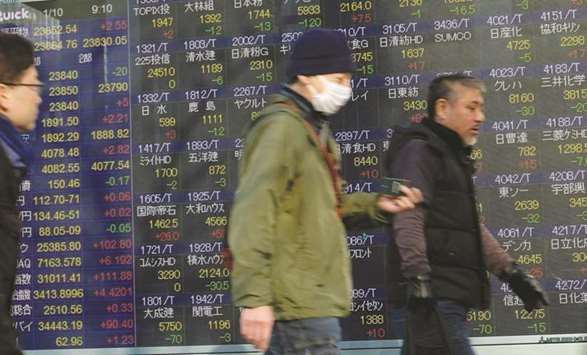Strong economic fundamentals and corporate earnings as well as optimism about the impact of Donald Trump’s massive US tax cuts have helped fuel a global advance to record or multi-year highs.
However, some analysts say the surge has also been propelled by a fear of missing out, and with the next round of company reports about to kick off traders are taking a breather before making their next moves.
“You have to ask yourself what has changed really in these first six trading days of 2018, which has so materially driven prices higher?” said Greg McKenna, chief market strategist at AxiTrader.
“For me, the rally is starting to feed on itself, or people’s fear of not participating in the upside, despite the fact that I also believe the global growth outlook and the impact of US tax cuts is a positive.”
Tokyo ended 0.3% down at 23,788.20, Sydney shed 0.6%, while Singapore gave up 0.2% and Seoul lost 0.4%.
Wellington and Taipei each sank 0.8%.
However, Hong Kong continued its outstanding run by rising 0.2% at 31,073.72 – a 12th successive gain that puts it less than 900 points off its record high of 31,958.41 hit in October 2007.
Shanghai finished up 0.2%, a ninth straight advance.
Jonathan Slone, chief executive officer of CLSA, told Bloomberg TV that traders were in for some nail-biting months. “Markets will be higher at the end of next year than they are right now, in my opinion, but it’s going to be a little volatile getting there,” he said.
Despite the losses on broader markets, energy firms stood out as oil pushed higher.
Crude has more than doubled from its lows below $30 back in early 2016, supported by an output freeze deal between Opec and Russia and, recently, tensions in the oil-rich Middle East.
Market-watchers say unrest in key producer Iran could dent the country’s capacity, while others point out that any suppression of protests by Tehran could also lead Trump to reimpose export sanctions.
Both main oil contracts jumped more than 1% on Tuesday, also helped by data showing a huge drop in US stockpiles as a big freeze in the northeast fans demand for heating fuel.
That has helped petroleum-linked firms.
In Hong Kong CNOOC, PetroChina and Sinopec were up between 0.7% and 1.3% yesterday while Inpex in Japan rose more than 2%.
The dollar weakened against the yen a day after the Bank of Japan said it would cut back on its purchasing of bonds as part of its huge stimulus programme.
While not massive, the move brings Japan into line with other central banks.
The greenback has struggled in recent months on expectations central banks are beginning to tighten monetary policy, closing the gap with the Federal Reserve.
The dollar held up against the Chinese yuan after the central People’s Bank of China made a technical tweak to its exchange mechanism that reduces some of its control over the unit.
The dollar bought 6.5278 yuan, compared with a low of 6.4975 on Tuesday, though it is still well down from the levels near 7 yuan seen around the beginning of last year.
The move raised fears the PBoC would depreciate the currency as it did in 2015, spurring a global market panic, though analysts pointed out the move was more technical.
“This policy shift is far from a repeat of the iron-fisted PBoC moves from yesteryear. But it does appear the central bank’s not-so-invisible hand was at work curbing the rapid appreciation of the yuan,” said Stephen Innes, head of Asia-pacific trading at OANDA.



